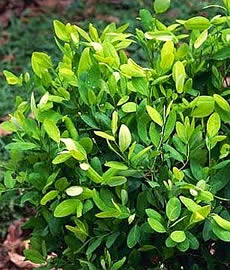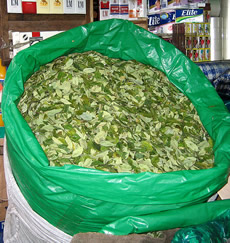World History
Coca (family Erythroxylaceae) is the generic name for several varieties of shrub that grow in the Andean mountains and adjacent tropical forests from whose leaves cocaine is derived.
Archaeological evidence from the Valdivia culture of southwestern Ecuador and elsewhere, including small ceramic figurines and containers, indicates that coca cultivation and chewing date back to at least 2500 b.c.e., making it likely that coca was among the first plants cultivated by the indigenous peoples of South America.
Known today as the gran remedio (great remedy), the plant’s small fleshy leaves are chewed, producing a mild narcotic effect that diminishes hunger and fatigue and produces an overall sense of well-being.
Traditionally viewed as a sacred plant, whose cultivation and ingestion were linked to various social rituals, coca was and remains integral to indigenous highland Andean culture, particularly among Quechua- and Aymara-speaking peoples.
The word coca itself derives from the Aymara word for tree. Several varieties of coca are cultivated in a variety of ecosystems, from windswept highlands to tropical lowlands. Its chemical composition, including its cocaine content, makes the plant highly resistant to pests and predators.

 It will also tolerate many harvests a year, a harvest consisting essentially of plucking a portion of the shrub’s leaves. The lifespan of a single shrub will typically extend up to 40 years, while the plant itself will tolerate a wide range of soils and ecological conditions, making it, in these respects, an ideal cultigen.
It will also tolerate many harvests a year, a harvest consisting essentially of plucking a portion of the shrub’s leaves. The lifespan of a single shrub will typically extend up to 40 years, while the plant itself will tolerate a wide range of soils and ecological conditions, making it, in these respects, an ideal cultigen.
The first documented use of coca by the indigenous inhabitants of the Americas comes from the 1499 journal of European explorer Amerigo Vespucci during his second voyage to the New World, in which he described the practice of coca chewing among the inhabitants of a Caribbean island off the coast of Venezuela. Later Spanish chroniclers decried the natives’s persistent use of coca, but proved unable to eradicate it.
The tens of thousands of indigenous laborers forced to work in the silver mines of potosÃ, for instance, routinely chewed coca, combined with ground seashells or other sources of alkalinity (which facilitates the body’s absorption of the plant’s active chemicals) in order to alleviate the effects of mine labor—a tradition that continued in Andean mines and elsewhere through the 20th century.
There is an important distinction between coca and cocaine. Coca refers to the plant and its leaves. Cocaine is but one chemical component of the plant, isolated and refined by chemical and physical processing. A chemical isolate, cocaine is highly addictive. Such chemical refinement is wholly antithetical to the traditional social and cultural use of coca leaves in highland South America.
There is no evidence that traditional coca chewing is addictive or harmful. On the contrary, abundant evidence exists that coca’s beneficial effects far exceed any potential negative side effects. Rich in vitamins and minerals, the plant is used for everything from toothaches to altitude sickness.
Coca, in short, is integral to highland Andean culture. Many informed observers are convinced that contemporary efforts to eradicate the plant from the Andes in the U.S.-led “War on Drugs†constitute a direct assault on indigenous culture and are doomed to failure.
Suggestive of the continuing cultural and political vitality and power of coca in the Andes, in 2006 the newly elected president of Bolivia ran on a platform of defending cocaleros (coca growers) from the assault on their traditional lifeways.
- Caciques In Latin America
Caciques in Latin America Cacique (ka-SEE-kay) is an umbrella term designating a wide variety of indigenous forms of political rule in pre-Columbian and postconquest Latin America, particularly Spanish America. In the Andean highlands, the equivalent...
- Cuzco (peru)
Cuzco (Peru) Cuzco was the center of the great Inca Empire, located in modern-day Peru. The word cuzco means “navel of the universe.†As in many other civilizations throughout history, this term suggests that the Incas saw themselves as the...
- Indigo In The Americas
Indigo in the AmericasPrized for its beauty as a deep blue dye for clothing and textiles, indigo has a long history in the Western world. Archaeologists have unearthed indigo-tinted fabrics in Greece dating to 2500 b.c.e., while the Greek historian Herodotus,...
- Evolution Of Santa
Evolution of Santa. The History Channel provides this history of Santa Claus. It begins, "The legend of Santa Claus can be traced back hundreds of years to a monk named St. Nicholas. It is believed that Nicholas was born sometime around 280 A.D. in Patara,...
- Andes Web Pages
Andes Web Pages - Andes related articles and photo galleries by James Q. Jacobs, covering archeological sites, history, prehistory and cosmology. Includes information on the lost cities of Machu Picchu and Tiwanaku as well as an account of the last Incan...
World History
Coca
 |
| Coca plant |
Archaeological evidence from the Valdivia culture of southwestern Ecuador and elsewhere, including small ceramic figurines and containers, indicates that coca cultivation and chewing date back to at least 2500 b.c.e., making it likely that coca was among the first plants cultivated by the indigenous peoples of South America.
Known today as the gran remedio (great remedy), the plant’s small fleshy leaves are chewed, producing a mild narcotic effect that diminishes hunger and fatigue and produces an overall sense of well-being.
Traditionally viewed as a sacred plant, whose cultivation and ingestion were linked to various social rituals, coca was and remains integral to indigenous highland Andean culture, particularly among Quechua- and Aymara-speaking peoples.
The word coca itself derives from the Aymara word for tree. Several varieties of coca are cultivated in a variety of ecosystems, from windswept highlands to tropical lowlands. Its chemical composition, including its cocaine content, makes the plant highly resistant to pests and predators.

 It will also tolerate many harvests a year, a harvest consisting essentially of plucking a portion of the shrub’s leaves. The lifespan of a single shrub will typically extend up to 40 years, while the plant itself will tolerate a wide range of soils and ecological conditions, making it, in these respects, an ideal cultigen.
It will also tolerate many harvests a year, a harvest consisting essentially of plucking a portion of the shrub’s leaves. The lifespan of a single shrub will typically extend up to 40 years, while the plant itself will tolerate a wide range of soils and ecological conditions, making it, in these respects, an ideal cultigen.The first documented use of coca by the indigenous inhabitants of the Americas comes from the 1499 journal of European explorer Amerigo Vespucci during his second voyage to the New World, in which he described the practice of coca chewing among the inhabitants of a Caribbean island off the coast of Venezuela. Later Spanish chroniclers decried the natives’s persistent use of coca, but proved unable to eradicate it.
The tens of thousands of indigenous laborers forced to work in the silver mines of potosÃ, for instance, routinely chewed coca, combined with ground seashells or other sources of alkalinity (which facilitates the body’s absorption of the plant’s active chemicals) in order to alleviate the effects of mine labor—a tradition that continued in Andean mines and elsewhere through the 20th century.
There is an important distinction between coca and cocaine. Coca refers to the plant and its leaves. Cocaine is but one chemical component of the plant, isolated and refined by chemical and physical processing. A chemical isolate, cocaine is highly addictive. Such chemical refinement is wholly antithetical to the traditional social and cultural use of coca leaves in highland South America.
 |
| Coca leaves |
Coca, in short, is integral to highland Andean culture. Many informed observers are convinced that contemporary efforts to eradicate the plant from the Andes in the U.S.-led “War on Drugs†constitute a direct assault on indigenous culture and are doomed to failure.
Suggestive of the continuing cultural and political vitality and power of coca in the Andes, in 2006 the newly elected president of Bolivia ran on a platform of defending cocaleros (coca growers) from the assault on their traditional lifeways.
- Caciques In Latin America
Caciques in Latin America Cacique (ka-SEE-kay) is an umbrella term designating a wide variety of indigenous forms of political rule in pre-Columbian and postconquest Latin America, particularly Spanish America. In the Andean highlands, the equivalent...
- Cuzco (peru)
Cuzco (Peru) Cuzco was the center of the great Inca Empire, located in modern-day Peru. The word cuzco means “navel of the universe.†As in many other civilizations throughout history, this term suggests that the Incas saw themselves as the...
- Indigo In The Americas
Indigo in the AmericasPrized for its beauty as a deep blue dye for clothing and textiles, indigo has a long history in the Western world. Archaeologists have unearthed indigo-tinted fabrics in Greece dating to 2500 b.c.e., while the Greek historian Herodotus,...
- Evolution Of Santa
Evolution of Santa. The History Channel provides this history of Santa Claus. It begins, "The legend of Santa Claus can be traced back hundreds of years to a monk named St. Nicholas. It is believed that Nicholas was born sometime around 280 A.D. in Patara,...
- Andes Web Pages
Andes Web Pages - Andes related articles and photo galleries by James Q. Jacobs, covering archeological sites, history, prehistory and cosmology. Includes information on the lost cities of Machu Picchu and Tiwanaku as well as an account of the last Incan...
